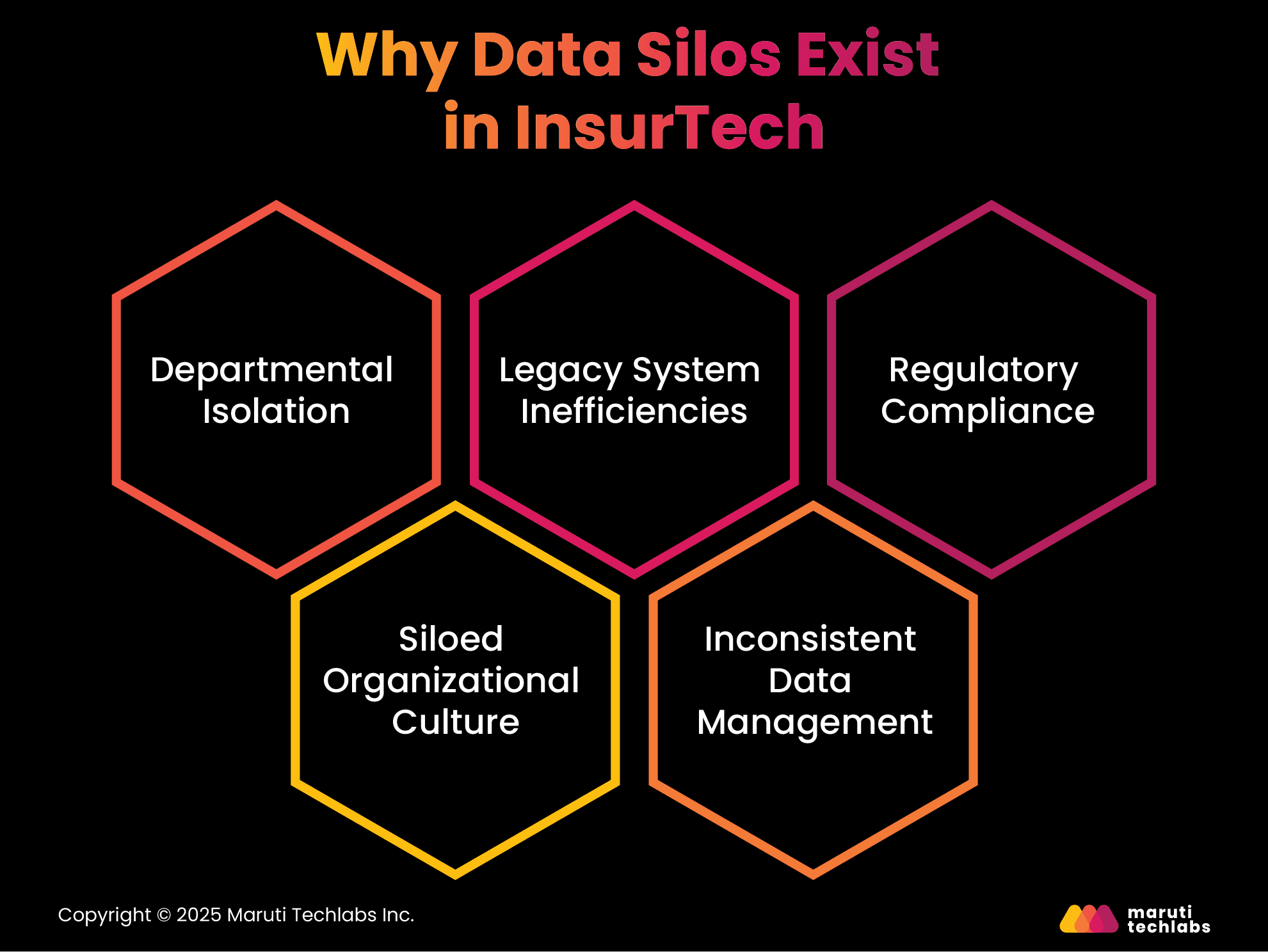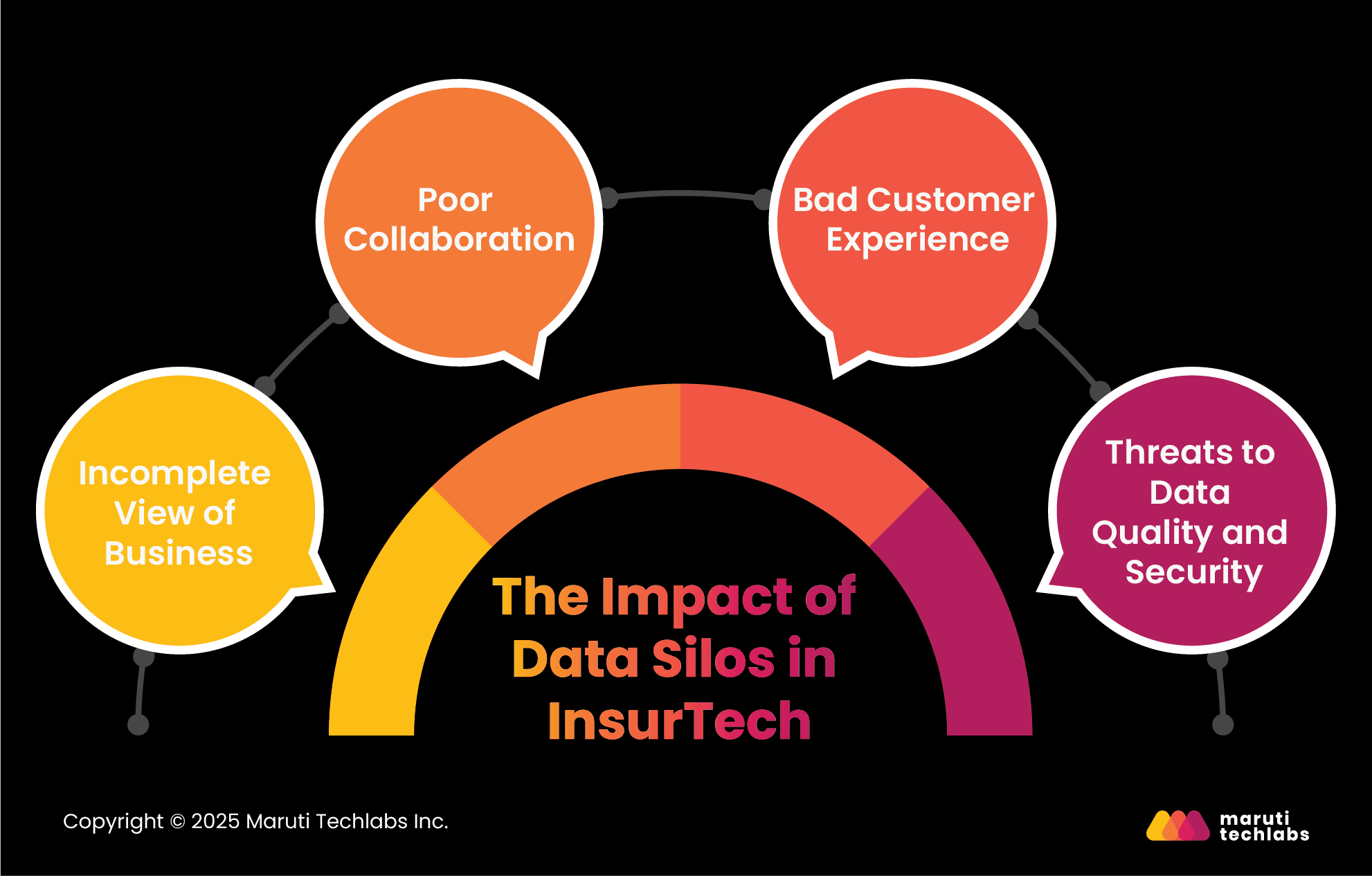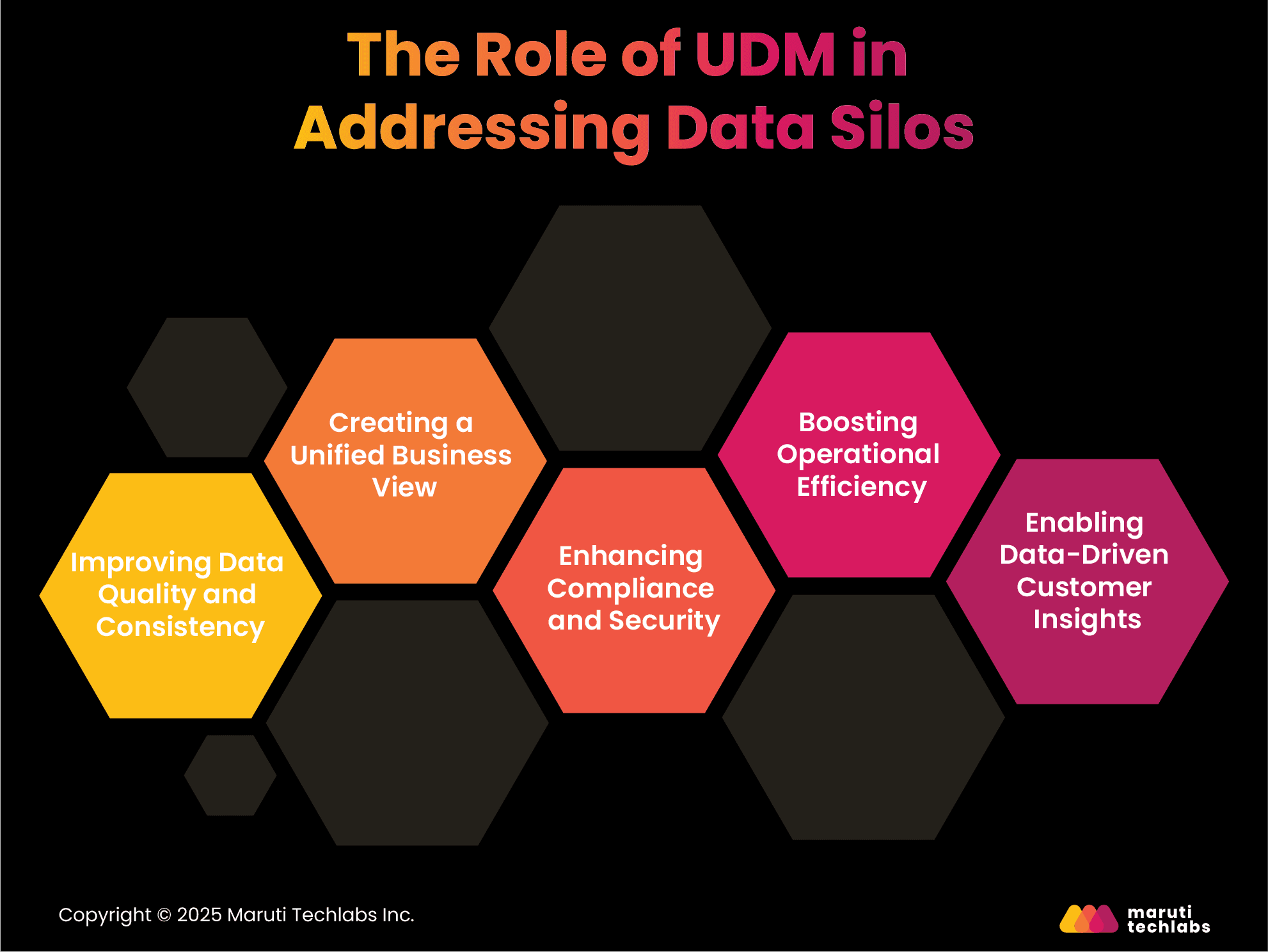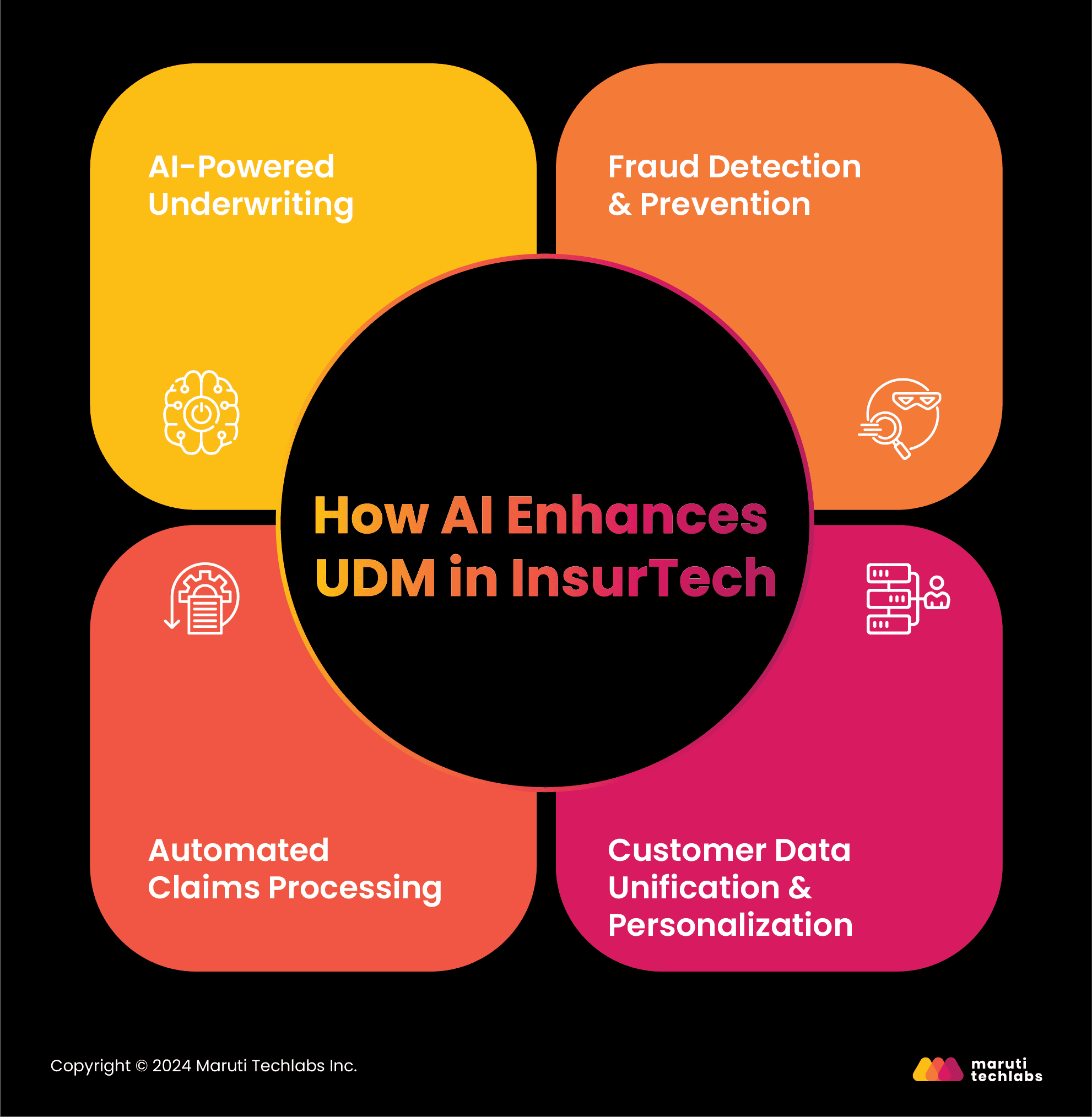

The Ultimate Guide to AI-Powered Unified Data Management in InsurTech






Insurance companies generate vast amounts of data from multiple sources—policy systems, claims records, customer interactions, and third-party providers. However, this data is often scattered across different platforms, leading to inconsistencies, inefficiencies, and compliance risks.
Each department operates within its system, which makes collaboration difficult. The sales team tracks customers one way, while marketing and customer service rely on entirely different tools. This lack of integration results in duplicated efforts, delays, and errors—like mismatched policy details across departments.
According to Forbes, 45% of executives say their company's data is not integrated across departments. When data is scattered across different systems, it’s tough for insurers to see the whole picture—whether it’s about customers or overall business operations. This is where AI-powered Unified Data Management (UDM) in insurance makes a real difference.
By connecting the dots, organizing data, and providing real-time insights, AI in insurance helps insurers work smarter, reduce inefficiencies, and offer a smoother experience for customers.
Data silos make it difficult for insurance companies to find and use their data effectively. But how do these silos form? It doesn't happen all at once. Over time, different teams and systems start working separately, each managing data in their own way. This creates gaps and makes it harder to connect information across the company.

Here's why this happens:
Many insurance companies let each department pick its own software and tools. It may seem like a good idea, but it often creates systems that don't connect. Sales, marketing, and claims teams use different platforms, making data sharing difficult and adding extra costs.
Many insurers still rely on outdated systems that weren't built to handle today's vast amounts of data. These older technologies struggle to support real-time analytics or integrate with modern business intelligence tools. As a result, companies are forced to use multiple applications to manage data which leads to deeper silos.
Insurance data management with strict compliance requirements is a constant struggle. Analysts often spend more time searching, cleaning, and organizing data rather than analyzing it. The rapid growth of data sources, including IoT devices and advanced tracking technologies, increases complexity and makes it even harder to maintain data accuracy and security.
In large insurance firms, teams often compete for control over data instead of sharing it. Employees might refrain from sharing information with other departments because they don't want to lose control. This prevents teams from working better together.
Many insurers know the value of data but still don't manage it well. Most of their data remains unstructured and scattered across different systems, which makes it difficult to analyze or leverage for decision-making. Insurers miss valuable insights that could drive business growth without a unified approach.
To utilize the full potential of their data, insurers need to break down silos. AI-driven Unified Data Management offers a way forward through seamless data integration and smarter decision-making.
Insurers need to break down data silos to make the most of their information. AI-powered Unified Data Management helps by connecting systems, making data easily accessible, and enabling better decision-making.
Data silos create major roadblocks for insurance companies and make it difficult to access, share, and use information effectively. This affects everything from business decisions to customer service. Let's see how:
When data is scattered across different systems, insurers struggle to clearly understand their business. It’s like trying to put together a puzzle with missing pieces. Without connected data, tracking performance, identifying trends, and making informed decisions become difficult.

Teams use different systems that don’t connect, which makes it difficult for them to work together smoothly. Managers often struggle to get the data they need from agents, making quick and informed decisions harder. Without easy access to information, employees spend valuable time searching for data instead of focusing on their actual work. This not only slows down operations but also affects overall productivity.
Customers interact with multiple departments—sales, claims, and support. When teams don’t share data, customers must repeat themselves, wait longer for help, or get different answers each time. This causes frustration for customers and makes them lose trust in the company.
Duplicate records, outdated entries, and missing information make data unreliable. If data is not handled correctly, it also increases security risks, especially when sensitive information is stored in personal files instead of secure systems.
Insurers must break these data barriers to work more efficiently, serve customers better, and make the most of their data.
AI-driven Unified Data Management (UDM) helps insurers break down data silos and create a seamless flow of information.

Here’s how AI-driven UDM makes a difference:
When data is scattered across different systems, mistakes, and outdated information pile up. UDM helps by sorting, cleaning, and organizing everything so insurers have accurate data they can trust. This makes it easier to make the right decisions without any guesswork.
If data is not connected, leaders do not fully understand their business. UDM consolidates information into a single source and gives insurers a 360-degree view of operations, performance, and customer interactions. This makes tracking key metrics and planning strategies much easier.
With strict rules like GDPR and HIPAA, insurers must keep data accurate, safe, and only available to the right people. UDM helps by maintaining records that are secure and well-organized, so there is a low risk of data leaks and rule violations.
When data is messy, it slows things down and leads to costly mistakes. UDM helps by matching records, removing duplicates, and fixing errors. This cuts down extra work so teams can focus on what matters.
UDM helps insurers keep track of customer history, choices, and interactions. This makes it easier to offer personalized services, spot fraud, and send better marketing messages. In the end, it keeps customers happy and loyal.
UDM connects data across teams and helps insurers make better decisions, stay secure, and run their business more smoothly.
AI in insurance is transforming how insurers manage and use their data.

By automating processes, detecting fraud, and improving customer experiences, AI-powered UDM helps insurers work smarter and faster. AI is making a difference in several key areas:
Underwriting has always been a key part of insurance. AI makes it faster and more accurate. It uses real-time data from telematics, wearables, and social media to assess risks.
For example, a driver’s habits—speeding, braking patterns, or late-night driving—can help insurers adjust premiums fairly. AI also spots trends in past claims to refine risk predictions. This means more precise pricing and coverage for policyholders.
Insurance fraud is a big challenge, but AI helps catch suspicious claims quickly in insurance. It scans large amounts of data to spot patterns that may indicate fraud.
For example, if multiple claims use the same accident photo, AI can flag them for review. It also tracks customer behaviors, like geolocation and transaction history, for detecting unusual activity. By identifying high-risk claims early, insurers can focus investigations where they matter most.
Filing claims can be a slow and frustrating process. AI speeds it up by analyzing images, documents, and reports automatically. Some platforms even assess car damage from customer-uploaded photos, reducing the need for physical inspections. AI also cross-checks claims with historical data to prevent fraud. With automated workflows, claims move faster, helping both insurers and customers save time.
Customers expect quick and personalized service. AI makes this possible by unifying data from different sources, giving insurers a complete view of each customer. Chatbots powered by AI handle queries, guide customers through claims, and assist with renewals—all in real time. AI can also personalize insurance policies based on a customer’s lifestyle, offering flexible coverage and fair pricing.
By enhancing underwriting, fraud detection, claims processing, and personalization, AI-driven UDM helps insurers deliver better service, reduce risks, and improve overall efficiency.
AI is helping insurers manage data better, improve efficiency, and reduce risks. Let us explore how:
AI looks at customer behavior and policy history to identify who might cancel their coverage. With these insights, insurers can offer personalized plans, discounts, or timely support to keep customers satisfied and loyal.
AI automates claims processing, document verification, and policy updates. This speeds up approvals, reduces errors, and improves customer experience.
AI gathers data from telematics, credit history, and social media to assess risk. This helps insurers price policies fairly and make quicker underwriting decisions.
AI helps insurers detect fraud by analyzing claim history, customer behavior, and transaction patterns. It flags high-risk cases for further review, reducing financial losses while ensuring legitimate claims are processed without delays. This improves fraud detection accuracy and streamlines investigations.
AI ensures insurers maintain accurate records, comply with regulations, and adapt to changing rules. It also tracks sustainability goals and simplifies regulatory reporting to make the process more transparent and more efficient.
Using AI-powered UDM, insurers can reduce risks, improve efficiency, and offer better services.
Insurance companies deal with massive amounts of data, but scattered systems create inefficiencies, errors, and compliance risks. AI-powered Unified Data Management (UDM) helps insurers break these barriers by organizing data, improving accuracy, and making real-time insights accessible. As insurance companies move toward digital solutions and data-driven decisions, companies investing in strong data management systems will stay ahead by improving efficiency, enhancing customer experiences, and meeting compliance requirements.
At Maruti Techlabs, we offer AI-driven solutions that help insurers unify their data, automate workflows, and gain real-time insights. Explore how our AI solutions can transform your insurance operations.
To assess your organization’s readiness for AI adoption, try our AI Readiness Assessment Tool and get a clear view of your current capabilities and next steps.
Unified Data Management (UDM) in insurance means combining data from different sources into one system. This helps companies make better decisions, work more efficiently, and improve customer service. By having all the data in one place, insurers can analyze trends, detect fraud, and personalize policies more effectively.
Data analytics helps insurers assess risks, detect fraud, and automate claims. It also improves pricing, customer segmentation, and underwriting. Telematics in auto insurance tracks driving behavior to set fair premiums. Overall, analytics reduces uncertainty, helps companies grow, and enhances customer satisfaction by making insurance more accurate and efficient.
AI cleans, organizes, and analyzes data. It removes errors, fills in missing information, and highlights key trends. By filtering out unnecessary details, AI helps businesses focus on valuable insights. It also automates data processes, ensuring accuracy, saving time, and making better predictions for smarter decision-making.
The UDM process gathers data from different systems and merges it into one central place, usually a data warehouse. This simplifies data management, reduces duplicate work, and improves accuracy. It also streamlines operations using a single framework, helping companies make data-driven decisions more efficiently and reliably.


